Abstract
Conformational energy calculations have been carried out for three hexadecapeptides in water--namely, a copolymer with the sequence acetyl-AAAAKAAAA-KAAAAKA-amide, 3K(I), in both the charged and neutral forms; a neutral peptide with the sequence acetyl-AAQAAAAQAAAAQAAY-amide, AQY; and a 16-residue L-alanine homopolymer with acetyl and amide terminal groups. The conformational energy was a sum of the empirical conformational energy program for peptides (ECEPP/2) potential energy plus continuum hydration free energy. An empirical (JRF) parameter set was used for the hydration free energy, together with an electrostatic contribution to the solvent effect from charged lysines. The computed relatively high helix content of the most probable conformation of charged 3K(I) and the intermediate helix content of AQY agree reasonably well with experimental values. The computed very low helix content of the alanine homopolymer agrees with experiments on block copolymers and on host-guest random copolymers. The calculations suggest that the high helix content computed for 3K(I) is due to the sum of internal and hydration free energies of the lysine residues rather than to a high intrinsic helix-forming tendency of alanine. The principal component lowering the computed helix contents of AQY and the alanine copolymer relative to 3K(I) is hydration.
Full text
PDF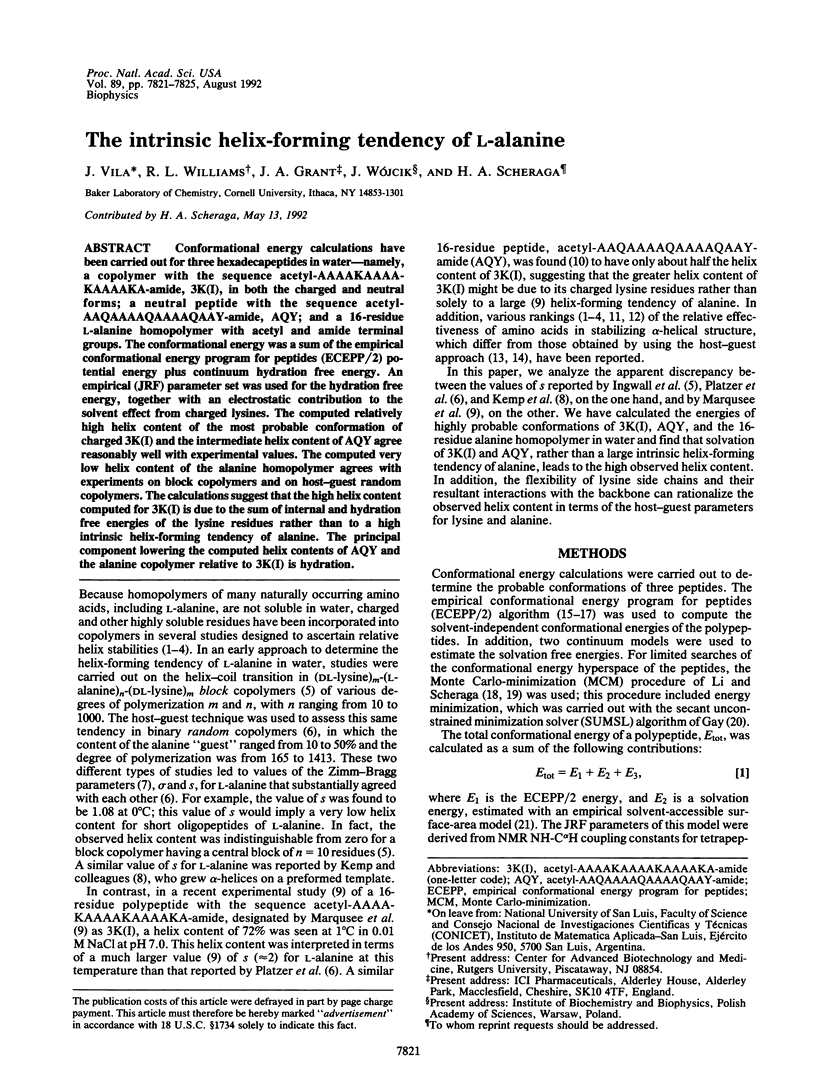
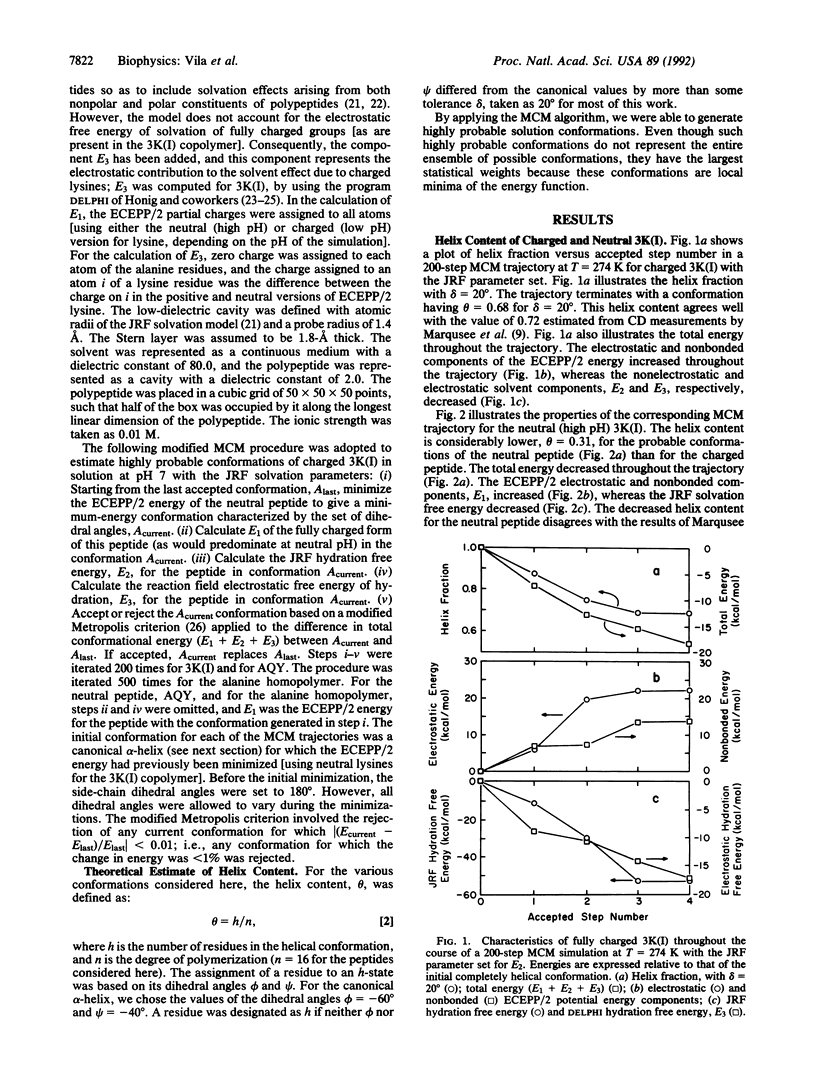
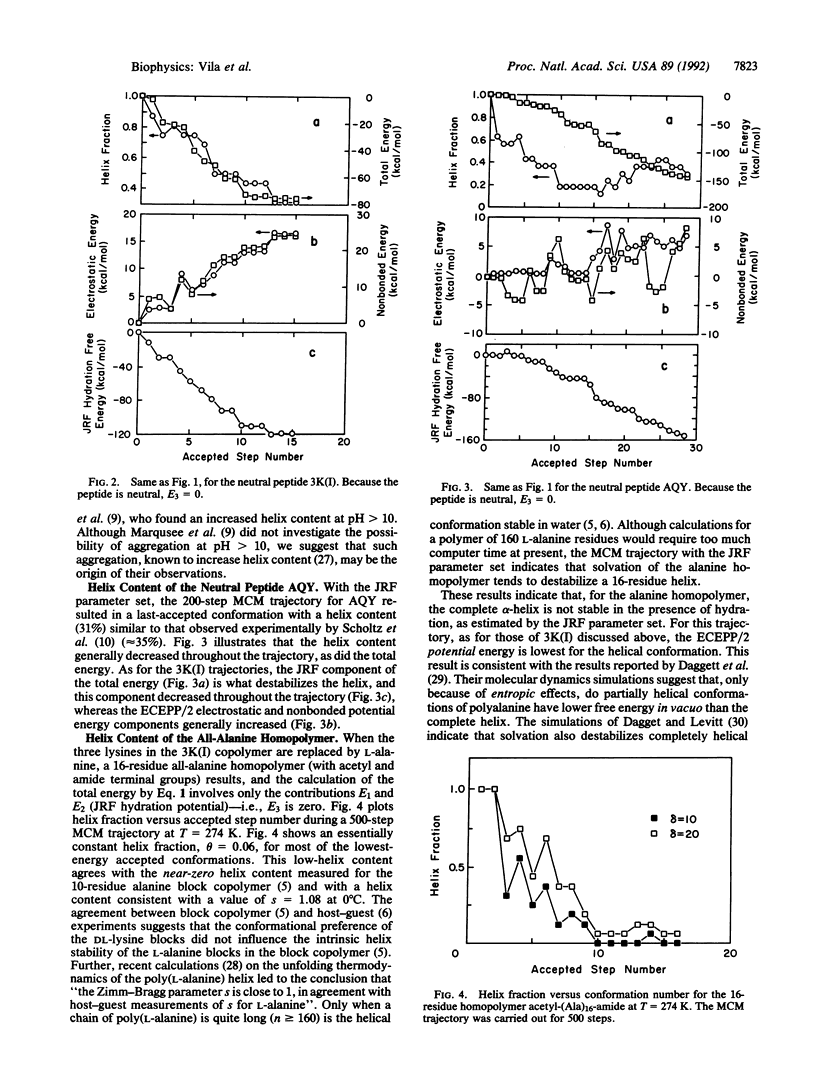
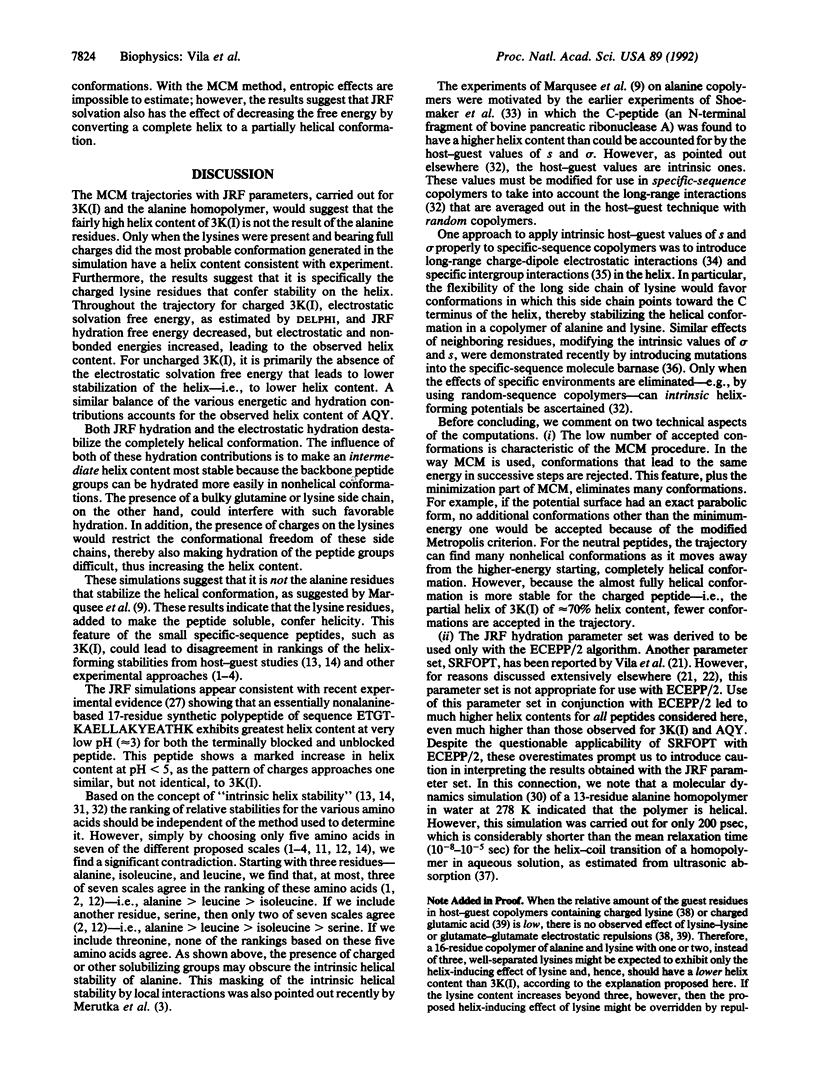
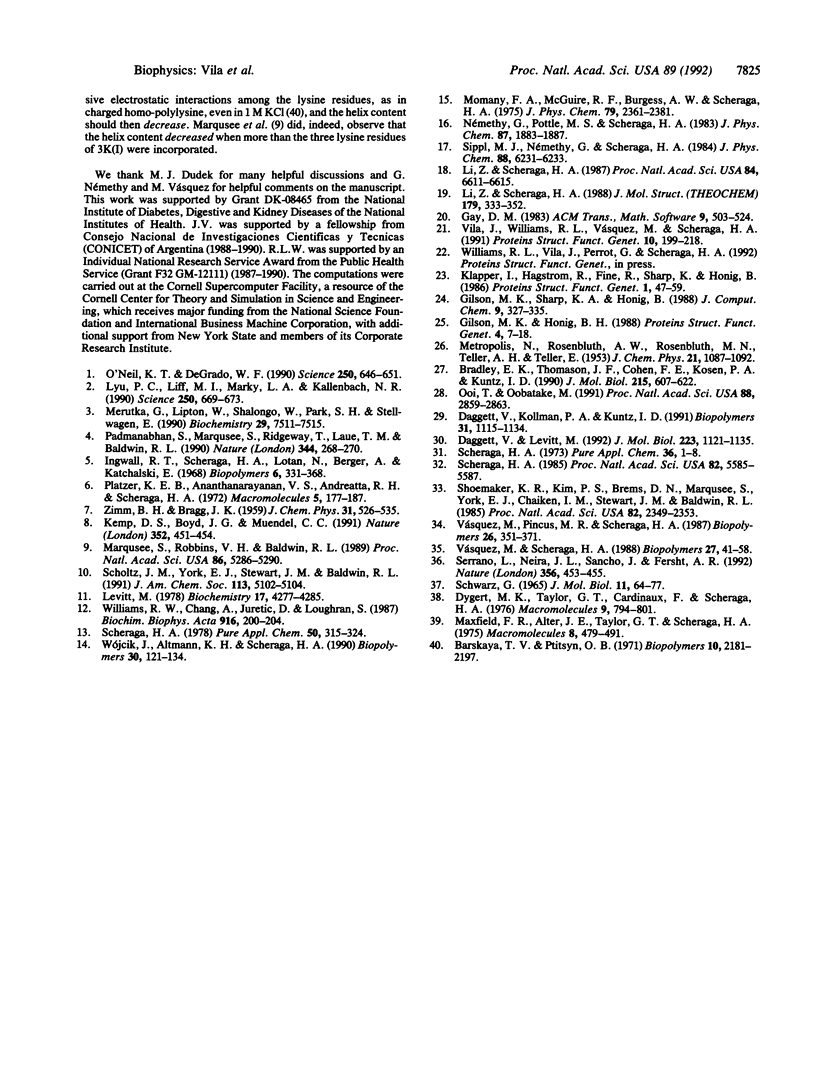
Selected References
These references are in PubMed. This may not be the complete list of references from this article.
- Barskaya T. V., Ptitsyn O. B. Thermodynamic parameters of helix-coil transition in polypeptide chains. II. Poly-L-lysine. Biopolymers. 1971 Nov;10(11):2181–2197. doi: 10.1002/bip.360101112. [DOI] [PubMed] [Google Scholar]
- Bradley E. K., Thomason J. F., Cohen F. E., Kosen P. A., Kuntz I. D. Studies of synthetic helical peptides using circular dichroism and nuclear magnetic resonance. J Mol Biol. 1990 Oct 20;215(4):607–622. doi: 10.1016/S0022-2836(05)80172-X. [DOI] [PubMed] [Google Scholar]
- Daggett V., Kollman P. A., Kuntz I. D. A molecular dynamics simulation of polyalanine: an analysis of equilibrium motions and helix-coil transitions. Biopolymers. 1991 Aug;31(9):1115–1134. doi: 10.1002/bip.360310911. [DOI] [PubMed] [Google Scholar]
- Daggett V., Levitt M. Molecular dynamics simulations of helix denaturation. J Mol Biol. 1992 Feb 20;223(4):1121–1138. doi: 10.1016/0022-2836(92)90264-k. [DOI] [PubMed] [Google Scholar]
- Dygert M. K., Taylor G. T., Cardinaux F., Scheraga H. A. Helix-coil stability constants for the naturally occurring amino acids in water. 11. Lysine parameters from random poly(hydroxybutylglutamine-co-L-lysine). Macromolecules. 1976 Sep-Oct;9(5):794–801. doi: 10.1021/ma60053a021. [DOI] [PMC free article] [PubMed] [Google Scholar]
- Gilson M. K., Honig B. Calculation of the total electrostatic energy of a macromolecular system: solvation energies, binding energies, and conformational analysis. Proteins. 1988;4(1):7–18. doi: 10.1002/prot.340040104. [DOI] [PubMed] [Google Scholar]
- Ingwall R. T., Scheraga H. A., Lotan N., Berger A., Katchalski E. Conformational studies of poly-L-alanine in water. Biopolymers. 1968;6(3):331–368. doi: 10.1002/bip.1968.360060308. [DOI] [PubMed] [Google Scholar]
- Kemp D. S., Boyd J. G., Muendel C. C. The helical s constant for alanine in water derived from template-nucleated helices. Nature. 1991 Aug 1;352(6334):451–454. doi: 10.1038/352451a0. [DOI] [PubMed] [Google Scholar]
- Klapper I., Hagstrom R., Fine R., Sharp K., Honig B. Focusing of electric fields in the active site of Cu-Zn superoxide dismutase: effects of ionic strength and amino-acid modification. Proteins. 1986 Sep;1(1):47–59. doi: 10.1002/prot.340010109. [DOI] [PubMed] [Google Scholar]
- Levitt M. Conformational preferences of amino acids in globular proteins. Biochemistry. 1978 Oct 3;17(20):4277–4285. doi: 10.1021/bi00613a026. [DOI] [PubMed] [Google Scholar]
- Li Z., Scheraga H. A. Monte Carlo-minimization approach to the multiple-minima problem in protein folding. Proc Natl Acad Sci U S A. 1987 Oct;84(19):6611–6615. doi: 10.1073/pnas.84.19.6611. [DOI] [PMC free article] [PubMed] [Google Scholar]
- Lyu P. C., Liff M. I., Marky L. A., Kallenbach N. R. Side chain contributions to the stability of alpha-helical structure in peptides. Science. 1990 Nov 2;250(4981):669–673. doi: 10.1126/science.2237416. [DOI] [PubMed] [Google Scholar]
- Marqusee S., Robbins V. H., Baldwin R. L. Unusually stable helix formation in short alanine-based peptides. Proc Natl Acad Sci U S A. 1989 Jul;86(14):5286–5290. doi: 10.1073/pnas.86.14.5286. [DOI] [PMC free article] [PubMed] [Google Scholar]
- Maxfield F. R., Alter J. E., Taylor G. T., Scheraga H. A. Helix-coil stability constants for the naturally occurring amino acids in water. IX. Glutamic acid parameters from random poly(hydroxybutylglutamine-co-L-glutamic acid). Macromolecules. 1975 Jul-Aug;8(4):479–491. doi: 10.1021/ma60046a021. [DOI] [PubMed] [Google Scholar]
- Merutka G., Lipton W., Shalongo W., Park S. H., Stellwagen E. Effect of central-residue replacements on the helical stability of a monomeric peptide. Biochemistry. 1990 Aug 14;29(32):7511–7515. doi: 10.1021/bi00484a021. [DOI] [PubMed] [Google Scholar]
- O'Neil K. T., DeGrado W. F. A thermodynamic scale for the helix-forming tendencies of the commonly occurring amino acids. Science. 1990 Nov 2;250(4981):646–651. doi: 10.1126/science.2237415. [DOI] [PubMed] [Google Scholar]
- Ooi T., Oobatake M. Prediction of the thermodynamics of protein unfolding: the helix-coil transition of poly(L-alanine). Proc Natl Acad Sci U S A. 1991 Apr 1;88(7):2859–2863. doi: 10.1073/pnas.88.7.2859. [DOI] [PMC free article] [PubMed] [Google Scholar]
- Padmanabhan S., Marqusee S., Ridgeway T., Laue T. M., Baldwin R. L. Relative helix-forming tendencies of nonpolar amino acids. Nature. 1990 Mar 15;344(6263):268–270. doi: 10.1038/344268a0. [DOI] [PubMed] [Google Scholar]
- SCHWARZ G. ON THE KINETICS OF THE HELIX-COIL TRANSITION OF POLYPEPTIDES IN SOLUTION. J Mol Biol. 1965 Jan;11:64–77. doi: 10.1016/s0022-2836(65)80171-1. [DOI] [PubMed] [Google Scholar]
- Scheraga H. A. Effect of side chain-backbone electrostatic interactions on the stability of alpha-helices. Proc Natl Acad Sci U S A. 1985 Sep;82(17):5585–5587. doi: 10.1073/pnas.82.17.5585. [DOI] [PMC free article] [PubMed] [Google Scholar]
- Serrano L., Neira J. L., Sancho J., Fersht A. R. Effect of alanine versus glycine in alpha-helices on protein stability. Nature. 1992 Apr 2;356(6368):453–455. doi: 10.1038/356453a0. [DOI] [PubMed] [Google Scholar]
- Shoemaker K. R., Kim P. S., Brems D. N., Marqusee S., York E. J., Chaiken I. M., Stewart J. M., Baldwin R. L. Nature of the charged-group effect on the stability of the C-peptide helix. Proc Natl Acad Sci U S A. 1985 Apr;82(8):2349–2353. doi: 10.1073/pnas.82.8.2349. [DOI] [PMC free article] [PubMed] [Google Scholar]
- Vasquez M., Pincus M. R., Scheraga H. A. Helix-coil transition theory including long-range electrostatic interactions: application to globular proteins. Biopolymers. 1987 Mar;26(3):351–371. doi: 10.1002/bip.360260305. [DOI] [PubMed] [Google Scholar]
- Vila J., Williams R. L., Vásquez M., Scheraga H. A. Empirical solvation models can be used to differentiate native from near-native conformations of bovine pancreatic trypsin inhibitor. Proteins. 1991;10(3):199–218. doi: 10.1002/prot.340100305. [DOI] [PubMed] [Google Scholar]
- Vásquez M., Scheraga H. A. Effect of sequence-specific interactions on the stability of helical conformations in polypeptides. Biopolymers. 1988 Jan;27(1):41–58. doi: 10.1002/bip.360270104. [DOI] [PubMed] [Google Scholar]
- Williams R. W., Chang A., Juretić D., Loughran S. Secondary structure predictions and medium range interactions. Biochim Biophys Acta. 1987 Nov 26;916(2):200–204. doi: 10.1016/0167-4838(87)90109-9. [DOI] [PubMed] [Google Scholar]


